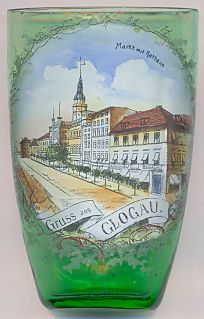

|
| POLSKA | POLAND |
| województwo: Dolnośląskie | voivodship: Lower Silesia |
| powiat: Głogów | county: Głogów |
Głogów (German: Glogau) is situated at an elevation of 79 m in the north of the voivodship Lower Silesia of southwestern Poland. Głogów is the seat of the administration of the district of the same name (powiat Głogowski).
The earliest written mention of Glogua is found in a chronicle of Thietmar of Merseburg. In 1253 it obtained the privileges of a town. The Piast duchy of Głogów was created with the partitioning of Lower Silesia in 1251. It was further partitioned in 1253 into Głogów (Glogau), Ścinawa (Steinau) and Żagań (Sagan). A further partition in 1312 gave rise to the duchies of Oleśnica (Oels) and Wołów (Wohlau). Together with most of the Silesian duchies, Głogów became a fief of the Bohemian Crown. When Głogów was partitioned again in 1368, one half fell to the duke of Żagań, the other fell to Bohemia and later, in 1383, to the dukes of Cieszyn (Teschen). After the death in 1476 of the last Piast duke of Głogów a lengthy dispute arose over the right of succession. This ended in 1482, when the northern parts (duchy of Krosno/Crossen) were sold to Brandenburg, while the southern parts (duchy of Głogów) were united again under Mathias Corvinus, king of Hungary and Bohemia. Together with Bohemia, the duchy in 1526 came in possesion of the Habsburgs. Together with most of Silesia, Głogów (in German: Glogau) became part of Prussia in 1742. Until 1945 Glogau was part of the administrative region Liegnitz (Legnica) of Lower Silesia.
 Shortly before the end of World War II Glogau was declared a fortress, whereupon it was besieged for six weeks
by the Red Army. The battle with the almost complete destruction of the historic city. After the war, Głogów
became part of Poland and the remaining German inhabitants were expelled.
The new city of Głogów was built in the outer districts of the old town, the ruins of the historic city were
cleared away with the exception of the ruins of the church of St. Nicholas, which remained as a memorial to the war.
It took until 1967, when the copper melting works were founded, that a new period of economic growth began.
The old historic city centre remained a cleared area until the 1980's when efforts to rebuild the old city centre
were initiated.
Shortly before the end of World War II Glogau was declared a fortress, whereupon it was besieged for six weeks
by the Red Army. The battle with the almost complete destruction of the historic city. After the war, Głogów
became part of Poland and the remaining German inhabitants were expelled.
The new city of Głogów was built in the outer districts of the old town, the ruins of the historic city were
cleared away with the exception of the ruins of the church of St. Nicholas, which remained as a memorial to the war.
It took until 1967, when the copper melting works were founded, that a new period of economic growth began.
The old historic city centre remained a cleared area until the 1980's when efforts to rebuild the old city centre
were initiated.
The historic  town hall dated back to the 13th century. After repeated damages, it was rebuilt
in the 16th century in Renaissance style. The building was totally rebuilt in 1831. The tower, built in the 1730's,
had a height of 80 metres. The town hall was destroyed after World War II. In 1984 it was decided to reconstruct the building.
The reconstruction was finished in 1995 and the new tow hall was inaugurated in 2002.
town hall dated back to the 13th century. After repeated damages, it was rebuilt
in the 16th century in Renaissance style. The building was totally rebuilt in 1831. The tower, built in the 1730's,
had a height of 80 metres. The town hall was destroyed after World War II. In 1984 it was decided to reconstruct the building.
The reconstruction was finished in 1995 and the new tow hall was inaugurated in 2002.
![[scale]](lineal.jpg)